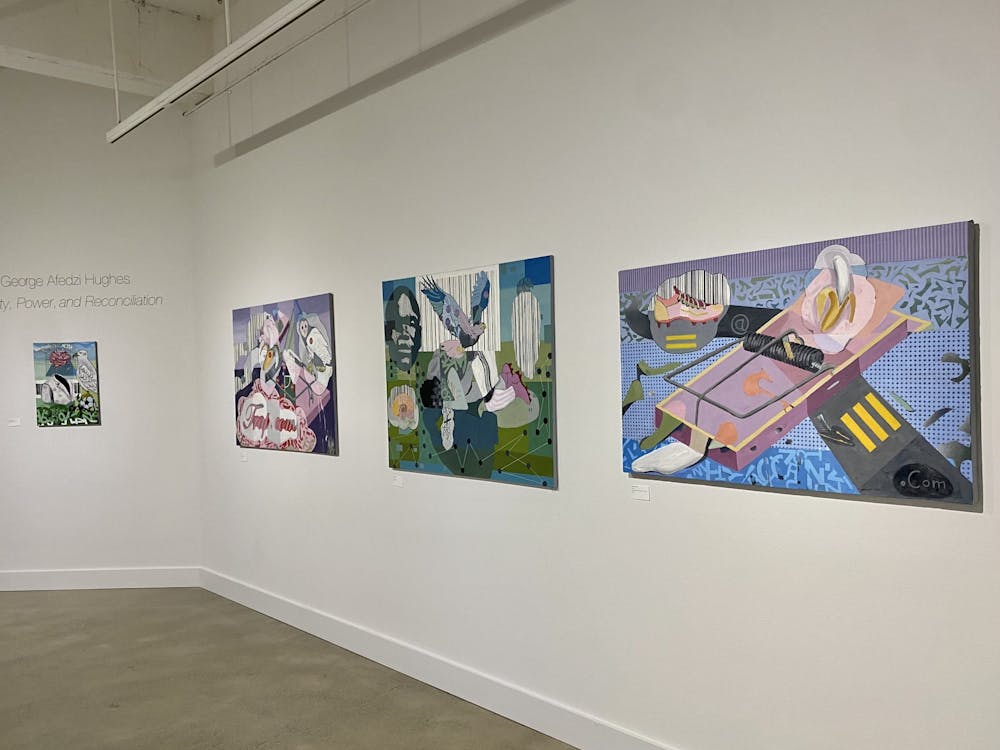Murals cover Buffalo Arts Studio’s walls, and sculptures fill its display rooms. Studios branch off the hallways, offering glimpses into resident artists’ minds.
And at the center of it all is George Hughes’ exhibit.
The room is filled with soft yet rich hues of pink, blue, purple and green. Sports and military imagery collide with fragmented URLs and barcodes.
“George— he’s a painter’s painter. I mean, he can paint the hell out of things,” Buffalo Arts Studio curator Shirley Verrico said.
Hughes, an associate professor of painting at UB whose art has been displayed and received praise everywhere from China to South Africa, debuted his solo exhibition “George Afedzi Hughes: Identity, Power, and Reconciliation” at Buffalo Arts Studio on Jan. 27.
“It’s a really wonderful opportunity to have a world-class artist like George Hughes showing here locally,” Verrico said. “He’s somebody that has lived literally around the globe. So I think there’s a lot of entry points, but once you’re engaged in the artwork, there’s a lot there. You can stay and stand in front of these paintings for a long time.”
The words “Identity, Power, and Reconciliation” were chosen carefully as the title of this exhibition. George Hughes’ identity in society is highly intersectional. In a space where someone could feel so alone, Hughes instead creates art that transcends labels and connects all corners of the world.
“I come across in society with multiple identities,” Hughes explained. “First as a human being, as an artist and other identities such as Black, African, Ghanaian and Fante. Furthermore, I can also be perceived with other implied identities such as an American, African American, immigrant, minority and so forth. These multiple identities come up depending on the circumstance.”
Hughes is able to connect deeply personal experiences to global and historical issues, making viewers feel understood by the work around them as they walk through the exhibition.
Hughes endured countless obstacles and challenges before becoming the artist he is today. These life experiences come together in his art as pieces of a painted collage. Barcodes litter each canvas as a nod to Hughes’ job during his first four years in the U.S., driving a forklift and scanning barcodes for eight hours a day.
Hughes is an avid soccer fan and was once a player himself. Soccer balls, cleats and other images of the game appear in almost every Hughes piece. These works portray his connection to the sport and acknowledge the horrible history of racism within the soccer world and prejudice against developing countries like his native Ghana. Black and Brown players are commodified and dehumanized by these European leagues. Bananas appear in his paintings to symbolize those that racist spectators have thrown on the field when Black players were in possession of the ball.
“Reconciliation” speaks largely to Hughes’ journey recovering from a serious accident in 2017, which left him mostly paralyzed from the neck down.
“I am interested in how we reconcile with our personal histories, memories and culture,” Hughes said. “I must reconcile with the trauma of my accident and lack of full mobility… The process of doing this requires artistic humor and metaphor.”
In his paintings, Hughes often depicts serious subjects in bright colors and humorous tones. Alongside the many pieces that explore soccer politics, “Yield” is a massive, 228 x 72 inch painting that depicts the fatal consequences of war in a pretty, pastel pink.
The combination of military imagery and pop-culture symbolism sheds light on corporations that profit from violent global conflicts. Hughes encourages viewers to compare this piece back to his others about the commodification of Black and Brown bodies in the soccer world. Furthermore, the military imagery also references a point in Hughes’s life when repurposed Army barracks served as his studio.
“Colonialism and trauma are relevant to my personal history and to a collective culture,” Hughes said. “Art and humor are universal and expressive visual forms of communication that cut across racial, ethnic and class boundaries.”
Pairing humor and metaphor with pop-culture iconography allows Hughes to create remarkably accessible artwork. “The work is smart and interesting and engaging, but it’s also so well-crafted,” Verrico said. “And that’s exciting, you know. To get an opportunity to see somebody’s work that is contextually rich, but also just so well crafted.”
“Identity, Power, and Reconciliation” by George Afedzi Hughes is on display in Suite 500 at the Buffalo Arts Studio until March 1.
The arts desk can be reached at arts@ubspectrum.com





